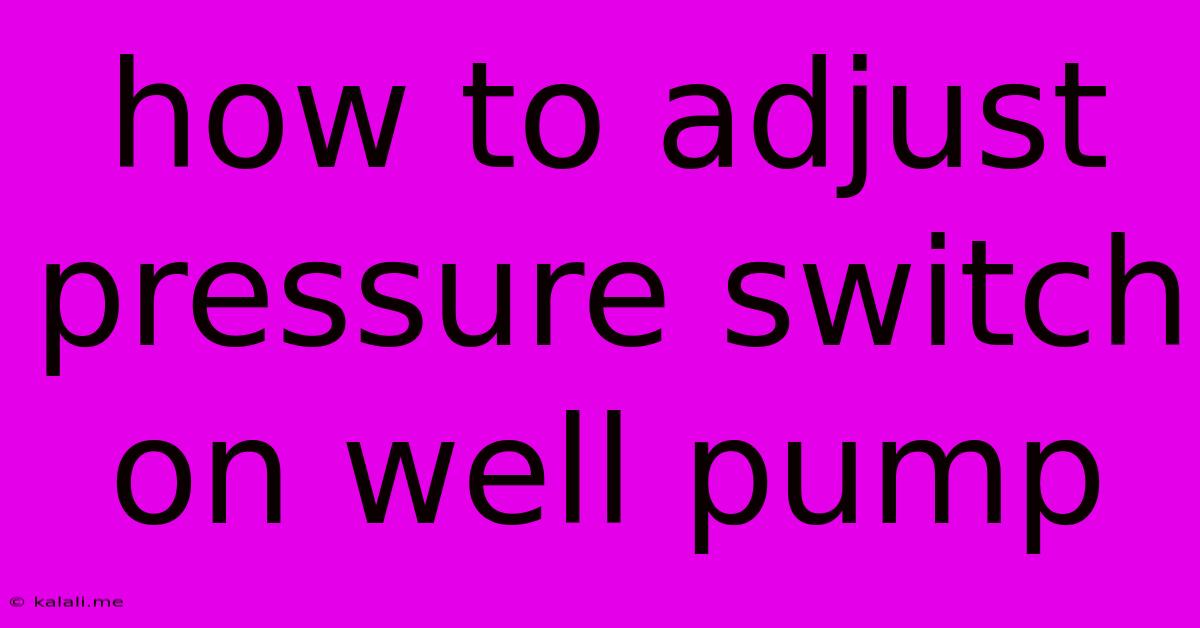How To Adjust Pressure Switch On Well Pump
Kalali
May 25, 2025 · 4 min read

Table of Contents
How to Adjust the Pressure Switch on Your Well Pump: A Comprehensive Guide
Meta Description: Learn how to adjust your well pump's pressure switch to optimize water pressure and prevent premature wear. This comprehensive guide covers troubleshooting, safety precautions, and step-by-step instructions for adjustment.
Maintaining consistent and reliable water pressure is crucial for any home reliant on a well pump. A properly adjusted pressure switch ensures your pump operates efficiently, preventing premature wear and tear and saving you potential repair costs. This guide provides a detailed walkthrough of how to adjust your well pump's pressure switch, including troubleshooting common issues and essential safety precautions.
Understanding Your Well Pump's Pressure Switch
Before you begin, understanding the components of your pressure switch is essential. The pressure switch is a crucial part of your well pump system, responsible for controlling when the pump turns on and off. It has two key settings:
- Cut-in Pressure: This is the pressure at which the pump turns ON. When your water pressure drops below this setting, the switch activates the pump.
- Cut-out Pressure: This is the pressure at which the pump turns OFF. Once the pressure reaches this setting, the switch deactivates the pump.
The difference between these two pressures (the differential) is also critical. A typical differential is around 20 PSI (pounds per square inch). For example, a common setting might be a cut-in pressure of 30 PSI and a cut-out pressure of 50 PSI.
Troubleshooting Common Issues
Before adjusting your pressure switch, troubleshoot potential problems that might mimic pressure switch issues:
- Low Water Levels: Check your well's water level. If it's low, adjusting the pressure switch won't solve the problem. You'll need to address the well's water source.
- Leaking Pipes: Inspect your plumbing system for leaks. Leaky pipes can cause a constant demand on your pump, leading to frequent cycling.
- Clogged Pipes: Blockages in your pipes can restrict water flow, causing the pressure switch to cycle improperly.
Safety First: Essential Precautions
Working with your well pump involves electricity and potentially pressurized water. Always prioritize safety:
- Turn Off the Power: Before starting any work, disconnect the power to your well pump at the breaker box.
- Release Pressure: Open a faucet to release any residual pressure in the system before working on the pressure switch.
- Use Appropriate Tools: Gather the necessary tools, including a screwdriver (likely a Phillips head), and possibly a pressure gauge for accurate readings.
- Consult a Professional: If you are uncomfortable working with electrical systems or plumbing, consult a qualified professional.
Step-by-Step Guide to Adjusting the Pressure Switch
Once you’ve completed the safety checks and troubleshooting, follow these steps to adjust your well pump's pressure switch:
-
Locate the Pressure Switch: The pressure switch is usually located near the well pump itself. It's typically a small, cylindrical device with several terminals and adjustment screws.
-
Identify Adjustment Screws: The pressure switch will have two adjustment screws: one for cut-in pressure and one for cut-out pressure. They are usually clearly marked or easily identifiable.
-
Use a Pressure Gauge (Recommended): For accurate adjustment, connect a pressure gauge to a faucet near the pump. This allows you to monitor the actual pressure while making adjustments.
-
Adjust the Screws: Slowly turn the adjustment screws using a screwdriver. A small clockwise turn will increase the pressure, while a counterclockwise turn will decrease it. Make small adjustments and monitor the pressure gauge readings.
-
Test the System: After making adjustments, turn the power back on and observe the pump’s operation. Listen for the pump's cycling and check the pressure gauge to ensure it's operating within the desired range. Repeat steps 4 and 5 as needed until the desired cut-in and cut-out pressures are achieved.
-
Restore Power and Monitor: Once you're satisfied with the adjustments, ensure everything is securely fastened, and restore power to the well pump. Monitor the system's performance for a few days to verify that the adjustments were successful.
Conclusion
Adjusting your well pump's pressure switch can significantly improve its efficiency and longevity. By following these steps and prioritizing safety, you can optimize your home's water pressure and prevent costly repairs. Remember, if you're unsure about any aspect of this process, it's always best to consult a qualified plumber or well pump technician.
Latest Posts
Latest Posts
-
How Do I Hang A Mirror On The Wall
May 25, 2025
-
Why Does My Cat Not Like To Be Held
May 25, 2025
-
Rebellion Is As A Sin Of Witchcraft
May 25, 2025
-
Rotary Encoder With Detents And Haptic Feedback
May 25, 2025
-
Outlets Not Working Breaker Not Tripped
May 25, 2025
Related Post
Thank you for visiting our website which covers about How To Adjust Pressure Switch On Well Pump . We hope the information provided has been useful to you. Feel free to contact us if you have any questions or need further assistance. See you next time and don't miss to bookmark.